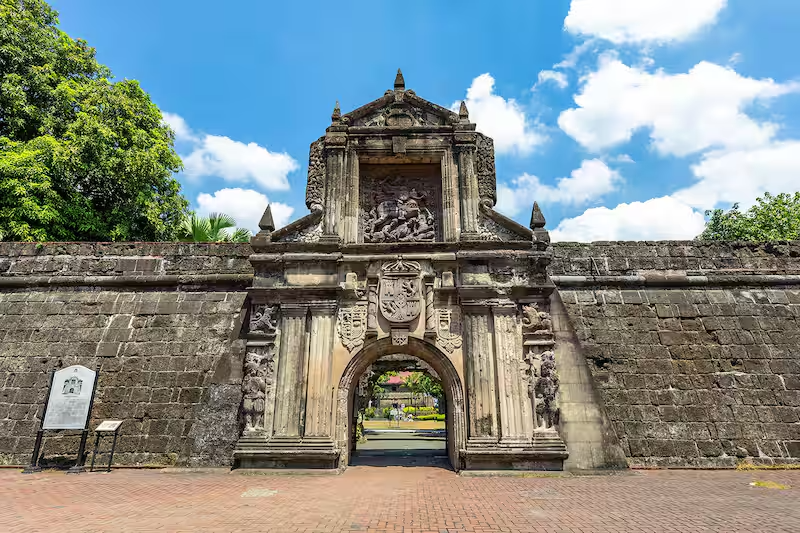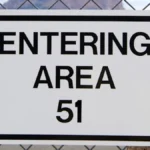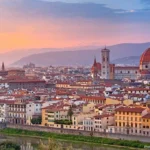
Intramuros, a historic walled city nestled in the heart of Manila, Philippines, stands as a timeless testament to the country’s rich colonial past and cultural heritage. Founded in 1571 under Spanish rule, this architectural marvel has endured centuries of history, from battles and earthquakes to periods of neglect and revitalization. Today, Intramuros is a vibrant cultural and tourist center, attracting millions of visitors each year with its cobblestone streets, centuries-old landmarks, and lively events. Join us as we delve into the fascinating world of Intramuros and uncover the stories woven into its ancient walls and bustling streets.
Founded: Intramuros was founded in 1571, with construction beginning under the Spanish Governor-General Miguel Lopez de Legazpi. This walled city was built as a defensive stronghold, serving as the seat of government and military headquarters during the Spanish colonial period in the Philippines. The construction of Intramuros marked the establishment of Manila as the capital of the Spanish East Indies and laid the foundation for centuries of colonial rule in the archipelago. Led by Spanish and indigenous laborers, the construction of the walls and fortifications was a monumental feat of engineering and architecture, designed to protect the city from foreign invaders and local uprisings. Intramuros quickly became the center of political, religious, and economic life in Manila, shaping the development of the city and the surrounding region.
Area: Intramuros encompasses an area of 0.66 square kilometers (0.26 square miles), encompassing most of modern-day Manila within its walls at the time of construction. The city was strategically located on the southern bank of the Pasig River, providing natural defenses on three sides and access to maritime trade routes. The compact layout of Intramuros facilitated defense and administration, with its streets laid out in a grid pattern centered around the Plaza Mayor (now Plaza de Roma). Within its walls, Intramuros contained government buildings, churches, convents, schools, markets, and residential areas, creating a self-contained urban center that was the heart of Spanish Manila.
Wall Thickness: The walls of Intramuros were up to 6.7 meters (22 feet) thick at the base, providing formidable defense against invaders. Constructed of stone and mortar, the walls were designed to withstand artillery fire and siege tactics, making them a formidable barrier to would-be attackers. The thickness of the walls varied depending on the terrain and strategic considerations, with the strongest fortifications located along vulnerable points such as the waterfront and main entry gates. The sheer massiveness of the walls, combined with their height and strategic placement, made Intramuros virtually impregnable during its heyday as a colonial stronghold.
Wall Height: Originally, the walls of Intramuros ranged from 6 to 8 meters (20 to 26 feet) tall, with watchtowers reaching even higher. These towering walls provided both defense and surveillance, allowing Spanish soldiers to keep a vigilant eye on potential threats from the surrounding countryside and the sea. The height of the walls also served as a deterrent to would-be attackers, intimidating them with the sheer scale of the fortifications. The watchtowers, strategically positioned along the walls, provided vantage points for sentries to observe enemy movements and signal warnings to the city below. As a symbol of Spanish power and authority, the towering walls of Intramuros loomed large over Manila, dominating the skyline and instilling a sense of security among its inhabitants.
Seven Gates: Intramuros once had seven entry points, each with a unique name and purpose. Only four gates remain standing today: Puerta del Parian, Puerta Real, Puerta Isabel II, and Puerta Santa Lucia. These gates served as portals to the bustling city within, welcoming traders, travelers, and soldiers while providing controlled access to the outside world. Each gate was named for its location, function, or historical significance, reflecting the diverse roles played by Intramuros as a commercial hub, military stronghold, and administrative center. Today, the surviving gates stand as silent sentinels of Intramuros’ storied past, evoking memories of a bygone era when the city was at the heart of Spanish colonial power in the Philippines.
Fort Santiago: Built in 1571, Fort Santiago is the oldest standing fort in the Philippines and served as the military headquarters for centuries. Strategically located at the mouth of the Pasig River, the fort controlled access to Intramuros and protected the city from naval attacks. Fort Santiago played a pivotal role in the defense of Manila during numerous conflicts, including the British invasion of 1762 and the Philippine Revolution of 1896. Over the centuries, the fort underwent several renovations and expansions, with its iconic facade and imposing walls still standing today as a testament to its storied history. Today, Fort Santiago is a popular tourist attraction, offering visitors a glimpse into the Philippines’ colonial past and the tumultuous events that shaped its destiny.
San Agustin Church: Completed in 1607, San Agustin Church is the oldest stone church in the Philippines and a UNESCO World Heritage Site. This magnificent church is renowned for its Baroque architecture, ornate interiors, and rich religious history. San Agustin Church has survived numerous earthquakes, wars, and natural disasters, standing as a symbol of resilience and faith amidst adversity. The church’s interior features intricately carved wooden altars, stunning frescoes, and a majestic pipe organ, showcasing the craftsmanship of Filipino artisans and Spanish craftsmen. Today, San Agustin Church continues to serve as an active place of worship and a cultural landmark, attracting visitors from around the world who come to admire its beauty and historical significance.
Battle of Manila (1762): In 1762, British forces captured Intramuros after a month-long siege, marking a turning point in Philippine colonial history. The Battle of Manila was part of the wider Seven Years’ War between Britain and Spain, with the British seeking to gain control of valuable colonial territories in Asia and the Americas. The capture of Intramuros by the British led to the brief occupation of Manila and the surrounding areas, resulting in significant upheaval and change. Although the British occupation was short-lived, lasting only two years, it left a lasting impact on Philippine society and politics, contributing to the eventual decline of Spanish colonial power in the archipelago.
Earthquake Damage: Intramuros has endured numerous earthquakes throughout its history, with major ones in 1645 and 1880 causing significant damage. The Philippines lies along the Pacific Ring of Fire, a volatile seismic zone prone to earthquakes and volcanic activity. As a result, Intramuros has been repeatedly shaken by powerful tremors, leading to the collapse of buildings, walls, and other structures. The earthquakes of 1645 and 1880 were particularly devastating, causing widespread destruction and loss of life. Despite the damage, the resilience of the people of Intramuros prevailed, and the city was rebuilt and restored each time, reflecting the enduring spirit of its inhabitants.
World War II: Intramuros was heavily damaged during the Battle of Manila in 1945, with much of its infrastructure destroyed. The Battle of Manila was one of the fiercest and bloodiest urban battles of World War II, as American and Filipino forces sought to liberate the city from Japanese occupation. The fighting resulted in the widespread destruction of buildings, homes, and cultural landmarks, including many within Intramuros. The once-proud walls and fortifications of the city were reduced to rubble, and its streets were littered with the debris of war. The Battle of Manila left an indelible mark on the city and its people, forever altering its landscape and reshaping its identity.
Post-War Neglect: Following World War II, Intramuros remained largely neglected for decades, becoming a slum area. The devastation wrought by the war left Intramuros in ruins, with many of its buildings reduced to rubble and its once-thriving neighborhoods deserted. In the post-war years, the focus of reconstruction efforts was on rebuilding Manila’s commercial districts and infrastructure, leaving little attention and resources for the restoration of Intramuros. As a result, the historic city fell into disrepair, with squatters occupying its abandoned buildings and makeshift settlements springing up amidst the ruins. The neglect of Intramuros was a stark contrast to its former glory as the jewel of Spanish Manila, highlighting the challenges of preserving historical heritage in the face of modernization and urban development.
Intramuros Administration (1979): Established by the Philippine government in 1979, the Intramuros Administration was tasked with overseeing the restoration and development of Intramuros. Recognizing the cultural and historical significance of the walled city, the government took steps to protect and preserve its heritage for future generations. The Intramuros Administration was given authority over planning, conservation, and tourism initiatives within the historic district, with a mandate to promote sustainable development while safeguarding its architectural and cultural treasures. Since its inception, the Intramuros Administration has played a crucial role in revitalizing the historic district, spearheading restoration projects, promoting tourism, and fostering community engagement.
UNESCO World Heritage Site: Intramuros was designated a UNESCO World Heritage Site in 1993 in recognition of its historical and cultural significance. This prestigious designation placed Intramuros among the world’s most important cultural landmarks, acknowledging its role as a testament to the Philippines’ colonial past and architectural heritage. The UNESCO World Heritage status brought international recognition and attention to Intramuros, highlighting the need for its preservation and conservation. With this designation, Intramuros joined the ranks of other iconic sites around the globe, such as the Great Wall of China and the Taj Mahal, as a symbol of humanity’s shared cultural heritage and history.
Casa Manila: Restored in 1981, Casa Manila is a 19th-century mansion that showcases Spanish colonial domestic life and architecture. This meticulously reconstructed ancestral home provides visitors with a glimpse into the opulent lifestyle of Manila’s elite during the Spanish colonial period. Casa Manila’s interiors are furnished with period-accurate furniture, artwork, and decor, recreating the ambiance of a bygone era. The mansion’s architectural details, such as its carved wooden doors, intricate tilework, and sprawling courtyard, exemplify the grandeur and elegance of Spanish colonial architecture. Today, Casa Manila serves as a museum and cultural center, offering guided tours and educational programs that bring the history of the Philippines to life.
Baluarte de San Diego: Completed in 1586, Baluarte de San Diego is one of the oldest bastions of Intramuros and now houses a museum about the city’s history. This well-preserved fortification was built to defend the city against attacks from land-based invaders and served as a key defensive position during times of conflict. Baluarte de San Diego’s thick walls, gun emplacements, and commanding views made it a formidable stronghold, capable of withstanding sieges and assaults. Today, the bastion stands as a testament to Intramuros’ military heritage and offers visitors a chance to explore its history through exhibits, artifacts, and interactive displays.
Km. 0 Marker: Located at Puerta del Parian, the Km. 0 Marker marks the official kilometer zero from which all distances in the Philippines are traditionally measured. This historic landmark serves as a point of reference for navigation and transportation throughout the archipelago, with highways, roads, and landmarks across the country using it as a starting point for their mileages. The Km. 0 Marker holds symbolic significance as the center of the Philippine road network, representing the convergence of routes and the interconnectedness of the nation. Visitors to Intramuros often stop at the marker to take photos and learn about its historical importance in shaping the country’s infrastructure.
Urban Redevelopment: Since the 1980s, Intramuros has undergone significant restoration and redevelopment efforts, transforming into a cultural and tourist center. The Intramuros Administration, in collaboration with government agencies, private organizations, and international partners, has spearheaded various initiatives to revitalize the historic district. These efforts have focused on restoring heritage buildings, improving infrastructure, enhancing public spaces, and promoting tourism. Urban redevelopment projects have breathed new life into Intramuros, attracting visitors with heritage tours, cultural events, and recreational activities. Today, the historic district stands as a vibrant hub of Philippine culture and history, welcoming millions of visitors each year from around the world.
Cobblestone Streets: Intramuros is known for its charming cobblestone streets, adding to its historical atmosphere. The narrow, winding streets of Intramuros are lined with centuries-old buildings, colonial-era churches, and Spanish-style plazas, evoking a sense of nostalgia for a bygone era. The cobblestone paving, made from smooth river stones set in mortar, reflects the city’s Spanish heritage and colonial past. Walking along the cobblestone streets of Intramuros is like stepping back in time, as visitors immerse themselves in the sights, sounds, and textures of old Manila.
Parks and Gardens: Several parks and gardens within Intramuros offer green spaces for relaxation amidst the historical sites. These tranquil oases provide respite from the hustle and bustle of the city, inviting visitors to unwind and appreciate the natural beauty of their surroundings. Intramuros’ parks and gardens feature lush vegetation, shaded pathways, and picturesque landscapes, creating a peaceful retreat in the heart of the urban jungle. Whether strolling through a manicured garden or lounging in a shady park, visitors to Intramuros can escape the heat and noise of the city while immersing themselves in its rich history and culture.
Intramuros Walk: A popular activity for tourists is a walk along the walls of Intramuros, offering panoramic views of the city. The fortified walls that once protected the city now provide a scenic vantage point for sightseeing and photography. Walking along the walls of Intramuros allows visitors to appreciate the scale and grandeur of its fortifications while taking in sweeping views of Manila’s skyline and landmarks. The Intramuros Walk offers a unique perspective on the city’s history and architecture, allowing visitors to imagine what life was like within the walled city centuries ago.
Cultural Events: Intramuros frequently hosts cultural events, festivals, and exhibits throughout the year. These events celebrate the rich heritage and diversity of Filipino culture, showcasing traditional music, dance, cuisine, and crafts. From religious processions and fiestas to art fairs and historical reenactments, there’s always something happening in Intramuros to captivate visitors and locals alike. Cultural events provide a platform for artists, performers, and artisans to share their talents and traditions with the wider community, fostering appreciation and understanding of Filipino culture.
Museums: Several museums within Intramuros showcase Philippine history, art, and religious artifacts. These cultural institutions offer insights into the country’s past, from pre-colonial times to the present day, through exhibits, artifacts, and interactive displays. Visitors can explore diverse topics such as colonial history, indigenous cultures, maritime heritage, and contemporary art, gaining a deeper understanding of the Philippines’ rich and complex heritage. Museums in Intramuros play a vital role in preserving and promoting Filipino culture, serving as educational resources for scholars, students, and curious travelers.
Kalesas: Horse-drawn carriages, known as kalesas, are a traditional mode of transportation within Intramuros, adding to the historical ambiance. These iconic vehicles evoke images of a bygone era when Spanish nobles and colonial officials traveled through the streets of Manila in elegant style. Today, kalesas offer visitors a leisurely way to explore the narrow streets and historic landmarks of Intramuros, providing a romantic and nostalgic experience reminiscent of old-world charm. The clip-clop of hooves on cobblestone streets and the jingle of harness bells create a sense of nostalgia for a simpler time, transporting passengers back to the colonial era.
Nightlife: Intramuros offers a variety of restaurants, bars, and cafes, making it a vibrant destination even in the evenings. After dark, the historic district comes alive with the sounds of laughter, music, and clinking glasses as locals and tourists gather to enjoy food, drinks, and entertainment. From cozy wine bars and rooftop lounges to lively pubs and karaoke joints, there’s something for everyone in Intramuros’ nightlife scene. Whether sipping cocktails with a view of the city lights or dancing the night away to live music, visitors can experience the vibrant energy and hospitality of Manila after dark.
Over 5 Million Visitors Annually: Intramuros attracts over 5 million visitors each year, making it one of the most popular tourist destinations in the Philippines. The historic district’s rich history, cultural attractions, and architectural treasures draw travelers from around the world who come to explore its cobblestone streets, centuries-old churches, and colonial-era buildings. From guided tours and heritage walks to cultural events and culinary experiences, there’s no shortage of things to see and do in Intramuros. As one of Manila’s top tourist attractions, Intramuros plays a vital role in promoting Philippine heritage and tourism, contributing to the country’s economy and cultural heritage.
5 Frequently Asked Questions About Intramuros:
What is Intramuros, and what does the name mean?
Intramuros is a historic walled city located in Manila, Philippines. The name comes from Spanish and translates to “within walls.” Built in the 16th century by the Spanish, it served as the seat of government for the Spanish colonial administration in the Philippines for over 300 years.
Today, Intramuros is a popular tourist destination known for its well-preserved Spanish colonial architecture and its rich history.
What are some of the must-see sights within Intramuros?
Intramuros boasts numerous historical landmarks, but some top picks include:
Fort Santiago: A massive citadel that served as the military headquarters of the Spanish colonial government. Explore its dungeons, museums, andRizal Shrine, dedicated to Philippine national hero Jose Rizal.
San Agustin Church: The oldest stone church in the Philippines, built in the 16th century, showcasing Baroque architecture and stunning interiors.
Manila Cathedral: The largest Roman Catholic cathedral in the Philippines, featuring neoclassical architecture and religious artifacts.
Casa Manila: A restored 19th-century Spanish colonial mansion offering a glimpse into the lives of wealthy Filipinos during that era.
How much does it cost to visit Intramuros?
There is no entrance fee to enter Intramuros itself. However, some individual attractions within the walled city, such as museums and Fort Santiago, charge admission fees. It’s best to check the specific sites you plan to visit for their individual pricing.
What is the best way to get around Intramuros?
Several options are available for exploring Intramuros:
Walking: The best way to experience the historical atmosphere is to walk along the cobblestone streets and take in the sights at your own pace.
Kalesa: Enjoy a traditional and unique experience by riding a horse-drawn carriage (kalesa) around the city walls.
Bike Rentals: Several places offer bicycle rentals, allowing you to cover more ground while still enjoying the open air.
Intramuros E-Jeepneys: These electric jeepneys offer a convenient and affordable way to get around to different points within Intramuros.
Is Intramuros safe for tourists?
Intramuros is generally considered a safe area for tourists. However, as with any tourist destination, it’s always wise to be aware of your surroundings and take precautions like not carrying large sums of cash or valuables.









